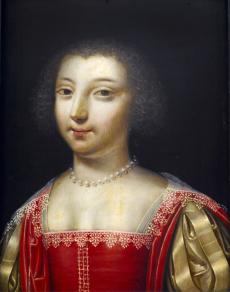


The face of the woman in this picture bears little resemblance to that in a painting by the same, or a very similar, hand in the Musée du Château de Versailles that is also called Marie de Bretagne, Duchesse de Montbazon, and no portrait of her sister, Anne de Bretagne, appears to be known. It is questionable, however, whether either of them is a real portrait at all, for they belong to a distinctive group of small bust portraits of women on panel, of which dozens are known, that may originally have formed little ‘galleries of beauties’ in both noble and bourgeois homes. Some of these ‘beauties’ were essentially imaginary courtesans (as is much more evident in related prints), but some were painted with coronets on their heads, to suggest that they were portraits of actual or imaginary princesses; and others either had or, by association with those, with time assumed, other noble identities. The largest surviving group of such pictures is at Wörlitz, where there are six of them, not one of which has been given an identity. One of these, shown wearing a coronet (no. 1421), is facially very similar to the subject of the present portrait; but so are some of the others – it is only that they face a different way.
The distinguishing features of these ‘portraits’ are well described by Lebédel-Carbonnel: large, almond-shaped eyes; a large nose; and/or the suggestion of a double chin. Intriguingly, the ideal of beauty that they represent appears partly to have been determined by the Mona Lisa – which was, of course, in the French Royal Collections. In the Musée des Beaux-Arts in Tours there is even a picture that is called, for this very reason, Buste de Femme Inspiré de la Joconde.
It is possible, however, that the artist responsible for these imaginary portraits also painted real ones. We know that Jean Ducayer, whose sole visually known production is limited to one picture of this kind (that has regrettably since disappeared from view, but whose appearance is known from a photograph of it in its frame, taken when it was shown at the Palais du Trocadero in Paris in 1878, of which there is a print in the Witt Library in London), also painted actual portraits. Not only did the picture that the Marquis de Chennevières lent to the Trocadero purport to be one, but there is also a record of Ducayer painting a mother and daughter of the highest nobility. The Trocadero picture was of a bourgeoise. It was inscribed on the back with the name of the artist, the year (1635) and the identity of the sitter: Marguérite Magdeleine Lecoq (though it is always possible that it was an imaginary portrait that the family had subsequently baptised with her name). The two recorded portraits were of Charlotte-Marguérite de Montmorency, Princesse de Condé (1593-1650), and her daughter, Anne-Geneviève de Bourbon-Condé, Duchesse d’Estouteville et de Longueville (1619- 1679). At Versailles, not only is there an anonymous early 17th-century portrait of the former on panel, of exactly the same type as the present picture, but there is also a pair of copies, done for Versailles in 1836 by Auguste de Creuse (1806-1839), of a pair of portraits of the two that were then in the collection of a descendant, the Duchesse de Montpensier, at the Château d’Eu, that were evidently also of the same character. It seems highly likely that those were the two recorded portraits by Ducayer, who can therefore be seen to have been able to paint both real and imaginary portraits, of high and low degree.
There is, sadly, no means of telling whether the present portrait is of the Duchesse de Montbazon or of her sister, or whether it is not rather of a courtesan (as the absence of a coronet – at least from a portrait purporting to be of the duchess – might suggest). They were the 4th and 11th children, respectively (and Marie was the eldest daughter), of Claude de Bretagne, Comte de Vertus et de Goëllo, Vicomte de Saint-Nazaire, Baron d’Avagour et d’Ingrande, Premier Baron de Bretagne (1581/2-1637), and his wife, Catherine Fouquet, daughter of Guillaume Fouquet, Marquis de la Varenne. Marie was married in 1628 to Hercules de Rohan, Duc de Montbazon, Pair et Grand Veneur de France (1577/8-1654), as his second wife. She bore him three children: François de Rohan, Prince de Soubise; Marie-Eléonore, abbess successively of La Trinité at Caen, and of Malnoüe; and Anne, second wife of Louis d’Albert, Duc de Luynes. Anne de Bretagne, Demoiselle de Goëllo, never married and was said simply to be over 80 when she died.
Little is known of this French artist, except that he likely painted both imaginary and actual portraits, in a distinctive group of small bust portraits of women on panel.